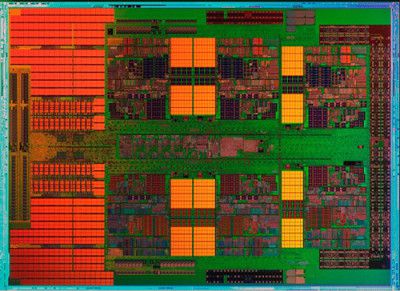From our front-page news:
Did you read our news post earlier this week regarding AMD's new 40W Opteron 2419 EE and wonder to yourself, "Cool, but where in the heck are the desktop variants?" Well, not surprisingly, there is no definitive answer, which is typical of almost any hardware launch. But, X-bit labs received information that claims we'll see the chips beginning next summer, if all goes well. Alright, that's not too soon, but it is expected.
The cool thing about these Hexa-Core processors is that they should be fully compatible with current AM3 motherboards, and possibly even AM2+. The architecture will allow for a dual-channel memory configuration supporting DDR3-1333 natively, and as the design follows Istanbul on the server side, you could expect to see the chip equipped with 3MB of L2 Cache, 512KB per core, and 6MB of shared L3 cache.
This six-core chip, codenamed "Thuban" (Arab for "Dragon"), might be released alongside some other new hardware, such as the 890FX and 890GX chipsets. These will bring new features to the table such as support for additional S-ATA ports and of course, the S-ATA 6Gbit/s specification. What else will it include? Only AMD seems to know at this point. It's still a ways off, but it shouldn't be too much longer before much more information is revealed.
AMD likely isn't stressing over the release of Thuban quite yet, as Intel isn't exactly prepared to release a desktop six-core chip either. That is scheduled to happen towards the middle of next year as well, with Gulftown, built on the 32nm node. Interestingly, Intel's Hexa-Core, like AMD's, will be fully compatible with the company's recent high-end chipset (X58).

Thuban is a star in the constellation of Draco and it also means "dragon" in Arabian language. The new six-core chip should be compatible with existing AM3 infrastructure (and, quite possibly, even with AM2+ infrastructure with split power plane), it remains to be seen whether Thuban becomes a part of AMD’s current high-end desktop platform called Dragon, or will power the company’s next-generation Leo platform.
Source: X-bit labs
The cool thing about these Hexa-Core processors is that they should be fully compatible with current AM3 motherboards, and possibly even AM2+. The architecture will allow for a dual-channel memory configuration supporting DDR3-1333 natively, and as the design follows Istanbul on the server side, you could expect to see the chip equipped with 3MB of L2 Cache, 512KB per core, and 6MB of shared L3 cache.
This six-core chip, codenamed "Thuban" (Arab for "Dragon"), might be released alongside some other new hardware, such as the 890FX and 890GX chipsets. These will bring new features to the table such as support for additional S-ATA ports and of course, the S-ATA 6Gbit/s specification. What else will it include? Only AMD seems to know at this point. It's still a ways off, but it shouldn't be too much longer before much more information is revealed.
AMD likely isn't stressing over the release of Thuban quite yet, as Intel isn't exactly prepared to release a desktop six-core chip either. That is scheduled to happen towards the middle of next year as well, with Gulftown, built on the 32nm node. Interestingly, Intel's Hexa-Core, like AMD's, will be fully compatible with the company's recent high-end chipset (X58).

Thuban is a star in the constellation of Draco and it also means "dragon" in Arabian language. The new six-core chip should be compatible with existing AM3 infrastructure (and, quite possibly, even with AM2+ infrastructure with split power plane), it remains to be seen whether Thuban becomes a part of AMD’s current high-end desktop platform called Dragon, or will power the company’s next-generation Leo platform.
Source: X-bit labs
